In a discovery that takes us just 73 light-years away, scientists have unearthed new insights into the formation and evolution of planets similar to our own. HD 63433 d, a newborn exoplanet orbiting a star similar to the Sun, is providing us with a tantalizing peek into what baby Earth might have looked like. With a size just slightly larger than Earth and an age of less than 500 million years, this exoplanet offers a rare window into the development of terrestrial worlds. While Earth remains the only planet currently known to harbor life, studying planets like HD 63433 d is crucial in our quest to understand the conditions that could support the emergence of life elsewhere in the vast Universe.
HD 63433 d, although both similar and dissimilar to Earth, presents an extraordinary opportunity for astronomers and astrophysicists alike. According to astrophysicist Melinda Soares-Furtado from the University of Wisconsin-Madison, HD 63433 d might mimic an early Earth due to its close orbit. This proximity allows scientists to explore potential evidence of outgassing and atmospheric loss, shedding light on how terrestrial planets evolve. However, that is where the similarities abruptly end, making HD 63433 d an intriguing celestial object.
A Young Star and Its Planetary Companions
Using the TESS exoplanet-hunting telescope, astronomers discovered HD 63433 d during a survey that scrutinizes stars for minuscule, regular fluctuations in starlight, indicating the presence of an orbiting planet. By studying the effects exerted by the exoplanet on the star’s light, scientists can determine its size and mass. HD 63433, a yellow dwarf star comparable in size and mass to the Sun, boasts a similar temperature profile. However, the star is significantly younger, with an age of just over 400 million years, in stark contrast to the Sun’s 4.5 billion years. Consequently, HD 63433 d and its fellow exoplanets are also infants in astronomical terms.
So far, the star system surrounding HD 63433 has yielded the discovery of three exoplanets. In 2020, two mini-Neptunes were identified, with HD 63433 d being the latest addition. Transit data obtained by tracking the dips in starlight as HD 63433 d orbits revealed a size 1.1 times that of Earth. While the planet’s mass remains undetermined, its dimensions strongly suggest a rocky composition akin to Earth, Venus, or Mars. HD 63433 d whirls around its star on an incredibly tight orbit, completing one revolution every 4.2 days. This close proximity implies that HD 63433 d is likely tidally locked, with one side perpetually facing the star.
The close proximity between HD 63433 d and its star has dramatic consequences for the planet’s conditions. Scientists predict that the hemisphere perpetually facing the star is immersed in scorching heat, resulting in a surface composed of molten rock. As a result, this exoplanet effectively resembles a gigantic lava ocean. While Earth never experienced such close proximity to the Sun, a massive collision leading to the formation of the Moon could have caused temperatures to soar to approximately 2,300 Kelvin. Nonetheless, HD 63433 d’s extreme characteristics present an unique opportunity to study the effects of intense heat on planetary surfaces.
Despite the wealth of information already gleaned from HD 63433 d, there is still much that remains unknown. Future research and follow-up studies hope to uncover additional details about the exoplanet, including its mass and density. These measurements are vital in determining the exoplanet’s composition and the potential existence of an atmosphere. By analyzing HD 63433 d and its companion star, scientists can gain valuable insights that will aid in the search for other planets among the roughly 100 similar stars in this young stellar group.
Unquestionably, HD 63433 d is a celestial neighbor worthy of our curiosity. With its Earth-like radius and orbit, it opens up an intriguing avenue for exploration into the complexities of planet formation and the conditions necessary to nurture life. As we eagerly await further revelations about this unique exoplanet, we embark on a journey to unravel the mysteries concealed within the vast expanses of our cosmic neighborhood.


Leave a Reply